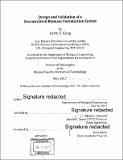Design and validation of a decentralized biomass torrefaction system
Author(s)
Kung, Kevin Su Yau
DownloadFull printable version (36.41Mb)
Other Contributors
Massachusetts Institute of Technology. Department of Biological Engineering.
Advisor
Ahmed F. Ghoniem.
Terms of use
Metadata
Show full item recordAbstract
To date, there has been limited usage of biomass and agricultural residues in rural areas as a form of renewable energy, mainly due to the expensive costs involved in collecting and transporting raw biomass. A decentralized biomass torrefaction system has the potential to upgrade the quality and transportability of distributed biomass residues in situ, thereby creating additional localized economic values and mitigating the environmental consequences associated with open burning of the excess biomass residues. Nonetheless, most existing biomass torrefaction systems so far have been designed for large-scale, centralized deployment, and are unsuitable to be scaled down in decentralized applications due to their high level of sophistication and capital cost. We propose a biomass torrefaction system based on the concept of torrefaction in a low-oxygen environment. By eliminating the stringent requirements of an inert torrefaction environment, we demonstrated that we can greatly simplify the reactor design and derive a laboratory-scale system that is also scalable. We proceeded to build and validate this torrefaction system with respect to different operating conditions and types of biomass. Using a quantitative definition for torrefaction severity, we were also able to relate the various fuel user requirements in real life back to the fundamental reactor operations. By quantifying in detail the overall energy performance, pressure requirements, and transient timescales, we also demonstrated how such a reactor system can be operated at scale, as well as the various design improvements that can further boost the performance of a scaled-up system. Therefore, this work builds the foundation towards the development of a low-cost, small-scale, and portable torrefaction system that can potentially be widely deployed in rural areas.
Description
Thesis: Ph. D., Massachusetts Institute of Technology, Department of Biological Engineering, 2017. Cataloged from PDF version of thesis. Includes bibliographical references (pages 226-238).
Date issued
2017Department
Massachusetts Institute of Technology. Department of Biological EngineeringPublisher
Massachusetts Institute of Technology
Keywords
Biological Engineering.